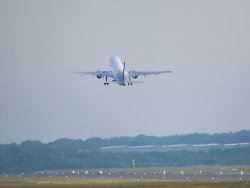Tuesday, July 6th, 2021
Pilots out of the exercise
New aviation risks loom after the crisis
The corona crisis could be read in the sky: the usual contrails were missing. In the meantime there are more flights again – but returning to everyday life in aviation is not entirely unproblematic. Insurers are preparing for new risks. One element of uncertainty: the passengers.
The gradual normalization of air traffic after a compulsory break of more than one year for many pilots and planes worries the alliance. The largest German insurer warned on Tuesday of the risks associated with demotion as well as of passengers out of control.
The experts at the industrial insurer AGCS, which belongs to the Munich-based Dax group, list the potential dangers in an analysis. This includes pilots who are out of practice and possible damage to the aircraft, for example nests in the engines, but also the cases reported from the USA of raging mask refusers on board. As far as pilots and airplanes are concerned, the concerns do not apply to the major airlines, but to what is known in the aviation industry as “general aviation”: smaller machines, from business flights to tourist flights to the use of rescue helicopters.
In the English-speaking world, the catchphrase “rusty pilots” is already making the rounds – rusty pilots. “If people are able to do their job little or not at all for a year and a half, the lack of practice is of course to be viewed with concern,” says AGCS claims manager Till Kürschner. In the medium term, the industry is also facing a shortage of pilots, with the threat of many aircraft being controlled by inexperienced pilots.
Apart from the pilots, planes and helicopters that have hardly been flown or have not flown at all for months could also pose a safety risk. In the USA, isolated insects have settled in parked machines. According to AGCS, no such cases are known from Germany. The pandemic has also accelerated the replacement of older machines with new, smaller ones, which would make repairs more expensive because of new materials, the AGCS analyzes.
As far as commercial aviation is concerned, according to Allianz experts, rioting passengers could be more of a risk than pilots or planes – also with a focus on the USA. Since the beginning of the year, the FAA has counted a good 3100 cases of “Air Rage” there. This means passengers who attack, threaten or insult cabin crew and other passengers. That was a multiple of the pre-corona numbers. 2350 of these 3100 cases were mask refusers. “Obviously, Americans find it harder than other compatriots to accept that there is a mask requirement,” says AGCS manager Axel von Frowein, who heads the insurer’s aviation business in Central and Eastern Europe. So far, however, there have been no major aviation claims at AGCS in connection with the pandemic.
.
